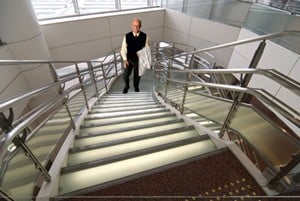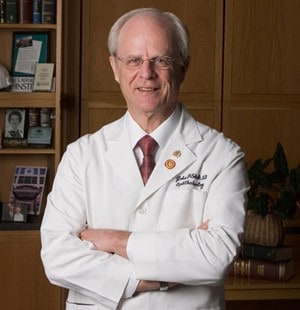Fifteen Years After JEI Dream Realized, Shock Steps Down
Jan. 19, 2010 | When John Shock, M.D., arrived at the University of Arkansas for Medical Sciences (UAMS) in 1979, he’d trek from his office in an old chemistry lab through the weeds and on broken sidewalks to reach the first eye clinic far across campus. One of two ophthalmologists, Shock came with the dream to improve eye care at UAMS and to develop an entity that would provide cutting-edge services, research and a world-class education program. Last fall, 30 years later and 15 years after his dream became reality in the Harvey & Bernice Jones Eye Institute he’s credited with constructing, Shock decided to step down as chair and director and pass the torch to the Institute’s second leader. Christopher Westfall, M.D., took over the position Jan. 1. “There comes a time when everyone needs to move on,” Shock said. “We had somebody who is extremely capable, qualified and ready to step in and it feels like a very natural progression, which is a good way to go out.” But stepping down is one thing, Shock said. Leaving it altogether is quite another. “I’m still going to have a couple clinic days and I’ll continue to help raise funds and support our new chair in any way I can,” he said. Vision for the Future “You have to understand what it was like back then,” Shock said. “Nobody ever thought about UAMS being a place where private-paying patients would come, but I thought otherwise.” Shock had become used to progressive thought after spending nearly a decade teaching an innovative technique he developed at Letterman Army Medical Center in San Francisco and later as chief of ophthalmology at the Brooke Army Medical Center. “After spending time at other institutions before coming to UAMS in 1979, I felt there were things we could do here that I had seen elsewhere,” Shock said. “I saw the direction we needed to go and made the decision to methodically go about accomplishing it.” Former UAMS Chancellor Harry Ward, M.D., arrived about the same time Shock did and was open to many of the ideas he presented to begin the evolution of eye care and research at UAMS. “We first moved from Shuffield Hall to the Ambulatory Care Center and with time doubled our clinic space there. Our administrative space also moved several times before we got the gifts to build the first phase of the Jones Eye Institute,” Shock said. Gifts for Growth He subsequently secured a $15 million gift from longtime UAMS supporter Pat Walker for the five-floor addition to JEI that provided more space for patient care, education and research. The Pat Walker Tower at the JEI, named for the Springdale philanthropist whose gift to UAMS made the expansion possible, doubled the 12-year-old original facility’s size when it opened in 2006. “Obviously philanthropy was key to our success and I feel very lucky to have had an opportunity that helped transform the Ophthalmology Department,” Shock said. “Our long-term relationships with wonderful philanthropists with the same goal are what made the difference.” In Shock’s time at UAMS, JEI has raised more than $50 million, which includes seven endowed chairs, a facility primed for growth and a growing faculty of clinicians and researchers. He also served as dean of the UAMS College of Medicine from 2000 to 2002 and executive vice chancellor of UAMS from 2002-2009, and has held nearly every leadership position on campus. “I feel very blessed to have served at UAMS,” he said. Clinic is Key Though he’s maintained clinic days throughout his time at UAMS, Shock said his primary focus has been growing JEI and helping to improve UAMS. Taking over where Shock left off is Westfall, who Shock said is a seasoned ophthalmologist and leader who has been at UAMS for 12 years. “It is an exciting time to move into this role and I look forward to leading JEI as Dr. Shock’s legacy achieves new heights,” Westfall said. Shock agrees that JEI has positioned itself for growth both in the clinical and research areas of eye care. “The future is very bright for JEI,” Shock said. “I look forward to my transition back into more of a clinical and support role and watching Dr. Westfall lead us into the future.” |

